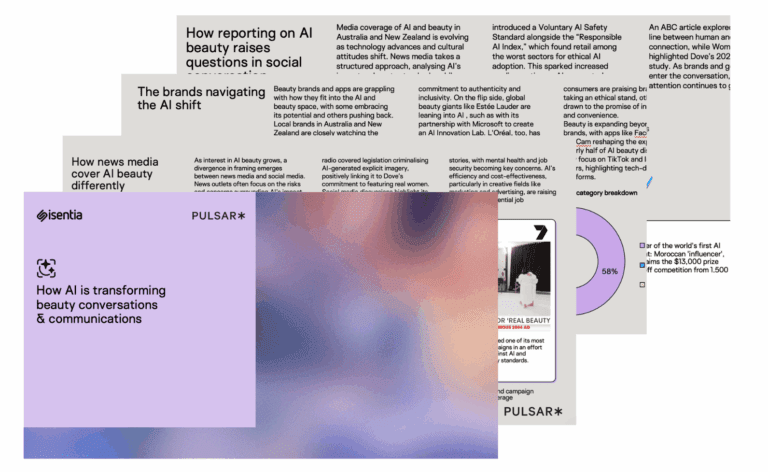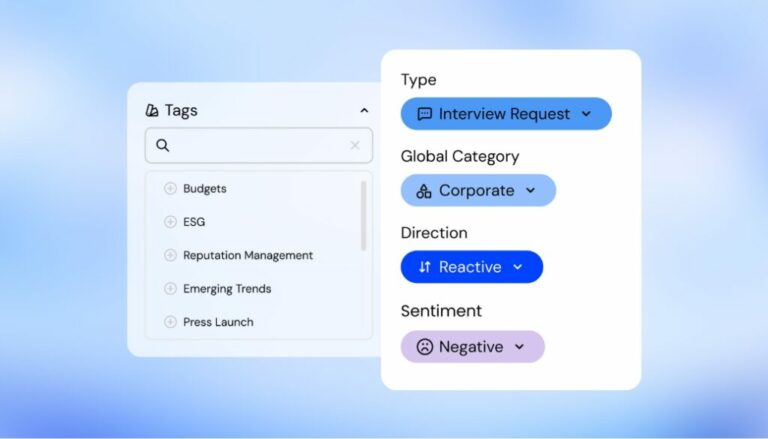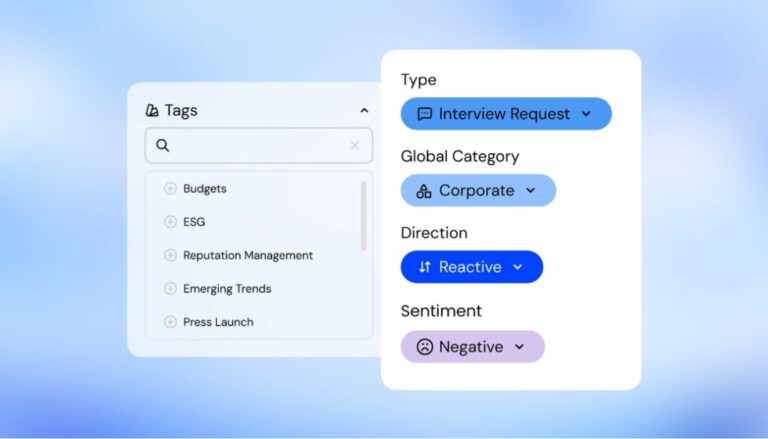Media Narratives, and Public Perceptions

object(WP_Post)#8429 (24) { [“ID”]=> int(37459) [“post_author”]=> string(2) “36” [“post_date”]=> string(19) “2025-02-10 22:15:40” [“post_date_gmt”]=> string(19) “2025-02-10 22:15:40” [“post_content”]=> string(2714) “ AI is reshaping the beauty industry, forcing brands to navigate a delicate balance between innovation and authenticity. While AI-driven tools offer hyper-personalised experiences and new creative possibilities, they also raise concerns about unrealistic beauty standards, ethical transparency, and audience trust. Brands must carefully craft their messaging—lean too far into AI, and they risk alienating audiences who crave innovation but are increasingly wary of artificiality. The challenge lies in meeting audience demand for cutting-edge beauty solutions while maintaining credibility in an industry where authenticity is everything. By analysing industry trends and online discussions, we uncover the shifts driving the next era of communications and visualisation, but through the lens of an industry that is one of the first to tackle AI intervention head-on. Key insights include: How AI is redefining beauty standards and personalisation The ethical considerations shaping trust and brand decisions The role of social media in amplifying AI beauty trends Get your copy now Download now ” [“post_title”]=> string(63) “How AI is transforming beauty conversations & communication” [“post_excerpt”]=> string(107) “Explore how journalism shapes trust, audience engagement, and media influence in...
Read more
Benchmarking OCR APIs on Real-World Documents

With the rapid advancements in Large Language Models (LLMs) and Vision-Language Models (VLMs), many believe OCR has become obsolete. If LLMs can “see” and “read” documents, why not use them directly for text extraction? The answer lies in reliability. Can you always be a 100% sure of the veracity of text output that LLMs interpret from a document/image? We put this to test with a simple experiment. We asked colleagues to use any LLM of their choice to extract a list of passenger names (10) from a sample PDF flight ticket. 💡 The results were quite interesting – Claude 3 Opus couldn’t read the PDF at all, Claude 3.5 Sonnet missed one passenger’s name, the output from ChatGPT o3-mini was completely made up (100% hallucination), ChatPDF missed half of the passengers on the list. Only NotebookLM and Deepseek got the list of names completely right! While LLMs can interpret and summarize documents, they lack the precision and structured output required for critical business applications where 100% data accuracy is crucial. Additionally, LLMs require significant computational resources, making them costly and impractical for large-scale document processing, especially in enterprise and edge deployments. OCR, on the other hand, is optimized for efficiency, running...
Read more
Why Apple Intelligence Might Fall Short...

As the tech world buzzes with the unveiling of Apple Intelligence, expectations are soaring. The leap from iPhone to AI-Phone paints a picture of a future where our devices aren’t just tools but partners capable of anticipating our needs and actions. Yet, amidst this enthusiastic anticipation, it’s crucial to examine the potential pitfalls that might cause Apple Intelligence to fall short of these lofty expectations. The very ambition that makes Apple Intelligence seem revolutionary could also be its Achilles’ heel. Apple plans to seamlessly integrate advanced AI across its suite of devices, promising an ecosystem where your iPad, iPhone, and Mac work together more intelligently than ever. However, the complexity of implementing such deep, cross-platform integration without glitches, privacy issues, or user frustration is immense. Could Apple be promising more than current technology realistically allows? Apple has long championed privacy as a cornerstone of its brand, yet the increased data processing required by Apple Intelligence could strain this commitment. With features like real-time language and image processing touted, the volume of data analyzed by AI will be vast. Even with promises of on-device processing, the potential for privacy breaches grows as more personal information is constantly analyzed by AI. Will...
Read more
ChatGPT’s New AI Image-Maker: ‘Astounding’

ChatGPT’s new AI-image generator – perfect for writers looking to add supplemental images to their copy — has become a viral sensation across the Web. Simultaneously embraced by millions of users as AI imaging’s ‘Next Big Thing,’ the new tool has been described as an ‘astounding’ leap forward by Al Samson, a graphic artist with 15+ years experience. Essentially, the new tool features stunning imaging, extreme detail and much more control over the final image users are looking to create, according to Samson. A few of the near-infinite number of use cases available with the AI imager include:~precise image rendering in a photo-realistic or illustration style~the ability to tweak an image of yourself to make yourselflook ‘more handsome,’ ‘more beautiful’ – or more or less exude any number of other qualities~the ability to drop a reliable image of your product into any scene you can imagine~instant-rendering of any image in your brand colors~instantly recognizable caricatures of celebrities and the famous~instant creation of a comic-strip in your desired style While not perfect, Samson says the new imaging tool – which replaces ChatGPT imaging that used to run on the DALL-E AI imaging engine has grabbed the crown as “the best image-generation...
Read more
Marek’s Dev Diary: 2025-01-16

What is this Every Thursday, I will share a dev diary about what we’ve been working on over the past few weeks. I’ll focus on the interesting challenges and solutions that I encountered. I won’t be able to cover everything, but I’ll share what piqued my interest. Why am I doing it I want to bring our community along on this journey, and I simply love writing about things I’m passionate about! This is my unfiltered dev journal, so please keep in mind that what I write here are my thoughts and will be outdated by the time you read this, as so many things change quickly. Any plans I mention aren’t set in stone and everything is subject to change. Also, if you don’t like spoilers, then don’t read this. Thursday 16.1.2025 Space Engineers 2 These are the main things I worked on recently: Default Volume: We are reviewing the default volume settings (it’s a little strange the default value is 50 on a scale 0 to 100, so we need to rethink this) Playtesting VS 1.2 (will be released sometime in next few months): Block Rotation: We tested a new method for how controls map to block rotation...
Read more
Setting the stage for election 2025:...

object(WP_Post)#8436 (24) { [“ID”]=> int(40160) [“post_author”]=> string(2) “36” [“post_date”]=> string(19) “2025-05-26 02:54:37” [“post_date_gmt”]=> string(19) “2025-05-26 02:54:37” [“post_content”]=> string(3706) “ Across the communications landscape, teams are being asked to do more with less, while staying aligned, responsive and compliant in the face of complex and often shifting stakeholder demands. In that environment, how we track, report and manage our relationships really matters. In too many organisations, relationship management is still built around tools designed for customer sales. CRM systems, built for structured pipelines and linear user journeys, have long been the default for managing contact databases. They work well for sales and customer service functions. But for communications professionals managing journalists, political offices, internal leaders and external advocates, these tools often fall short. Stakeholder relationships don’t follow a straight line. They change depending on context, shaped by policy shifts, public sentiment, media narratives or crisis response. A stakeholder may be supportive one week and critical the next. They often hold more than one role, and their influence doesn’t fit neatly into a funnel or metric. Managing these relationships requires more than contact management. It requires context. The ability to see not just who you spoke to, but why, and what happened...
Read more
Save up to $400 on Your...

For the next two weeks, you can save up to $400 on Tickets to the Chatbot Conference 2024. Whether you’re a returning attendee or new to our community, this is the perfect chance to experience the future of AI and chatbot technology at a discounted rate. Here’s What You Can Expect: Insightful Keynotes: Hear from pioneers and innovators who are shaping the world of conversational AI. Interactive Workshops: Dive into hands-on sessions where you’ll learn to design and build AI-Agent in 48hrs and earn a Certification. Networking Opportunities: Connect with top industry leaders and peers in the San Francisco Bay Area and from around the globe. If you want to learn more about the conference you see the Agenda, Testimonials and Workshops here. Simply go to the website and select the ticket marked SALE. But hurry, this offer is available for a limited time only! 🔖 Sale Details: Discount Offered: Enjoy $200 Off on Day 1 Passes & $400 Off on all 3 Days of the Chatbot Conference Sale Duration: Now through August 30th — don’t miss out! Don’t miss out on this opportunity to save on your ticket and join us for an unforgettable experience. We promise you a...
Read more
Top Ten Stories in AI Writing:...

This year’s first quarter served-up a number of watershed moments in the breakneck development of AI writers / chatbots. ChatGPT continued to turn heads with the announcement by its maker – OpenAI – that 400 million people now visit the ChatGPT Web site every week. And ChatGPT also unveiled a number of new upgrades – including major advances in AI imaging, editing and overall writing performance for writers. Meanwhile, a dark horse AI writer/chatbot from China – DeepSeek – stunned the world by releasing a chatbot alternative that was nearly as good as ChatGPT, but only cost pennies-on-the-dollar to make. Here’s a look at all the stories for Q1 that convinced many writers – as well as those across a wide spectrum of industries — that we are now living in an ‘AI First’ world: *New Study Finds AI-Powered Writing a Big Hit Among Many White Collar Pros: Stanford University researchers have found that AI writing is being heavily embraced by many white collar workers. Observes writer Matthias Bastian: “The impact is particularly noticeable in press releases, where up to 24% of content now comes from generative AI systems, or shows significant AI modification. “The researchers suspect that actual AI...
Read more
Marek’s Dev Diary: January 30, 2025

What is this Every Thursday, I will share a dev diary about what we’ve been working on over the past few weeks. I’ll focus on the interesting challenges and solutions that I encountered. I won’t be able to cover everything, but I’ll share what caught my interest. Why am I doing it I want to bring our community along on this journey, and I simply love writing about things I’m passionate about! This is my unfiltered dev journal, so please keep in mind that what I write here are my thoughts and will be outdated by the time you read this, as so many things change quickly. Any plans I mention aren’t set in stone and everything is subject to change. Also, if you don’t like spoilers, then don’t read this. Space Engineers 2 This week was very special – on Monday we launched SE2 on Early Access. The community reception has been very good, with most players understanding why we’re releasing an alpha and doing open development, sharing the journey together with them. Of course, SE2 doesn’t have as many features as SE1 yet, but it brings significant improvements (new VRAGE3, new visuals, new fractures, unified grids system, new...
Read more
How Labor and the Liberals are...

object(WP_Post)#8426 (24) { [“ID”]=> int(40160) [“post_author”]=> string(2) “36” [“post_date”]=> string(19) “2025-05-26 02:54:37” [“post_date_gmt”]=> string(19) “2025-05-26 02:54:37” [“post_content”]=> string(3706) “ Across the communications landscape, teams are being asked to do more with less, while staying aligned, responsive and compliant in the face of complex and often shifting stakeholder demands. In that environment, how we track, report and manage our relationships really matters. In too many organisations, relationship management is still built around tools designed for customer sales. CRM systems, built for structured pipelines and linear user journeys, have long been the default for managing contact databases. They work well for sales and customer service functions. But for communications professionals managing journalists, political offices, internal leaders and external advocates, these tools often fall short. Stakeholder relationships don’t follow a straight line. They change depending on context, shaped by policy shifts, public sentiment, media narratives or crisis response. A stakeholder may be supportive one week and critical the next. They often hold more than one role, and their influence doesn’t fit neatly into a funnel or metric. Managing these relationships requires more than contact management. It requires context. The ability to see not just who you spoke to, but why, and what happened...
Read more
